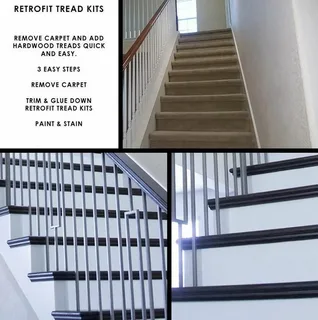When it comes to staircase remodeling, the goal is clear: create a seamless upgrade that delivers aesthetic appeal, safety, and durability—without disrupting the home or construction site. One of the most efficient solutions available today for meeting that goal is the use of retrofit stair treads.
Also known as “retreads” or “replacement treads,” retrofit stair treads are engineered to install directly over existing stair structures. Whether you’re converting carpeted stairs to hardwood or modernizing outdated steps in a renovation project, retrofit treads offer unmatched speed, quality, and professional finish.
What Are Retrofit Stair Treads?
Retrofit stair treads are hardwood overlays designed to fit over existing stair steps. They feature a built-in nosing and are usually thinner than traditional full-thickness treads, making them ideal for covering standard construction-grade stairs made of plywood or softwood.
This innovative design allows installers to avoid full demolition and replacement of the staircase structure. Instead, they simply prepare the existing stairs, cut the retrofit treads to size, and glue them in place using a durable adhesive.
This approach is ideal for:
- Remodeling projects with budget or time constraints
- Carpet-to-hardwood stair conversions
- Occupied residential spaces where minimal disruption is crucial
- Builders looking to standardize efficient processes across multi-unit projects
For professionals, this means a significant reduction in labor costs, material waste, and jobsite downtime.
Advantages of Retrofit Stair Treads in Professional Projects
1. Faster Turnaround Times
Unlike full stair replacements, retrofit treads can be installed in a fraction of the time. This is particularly useful in occupied renovations or on jobs with tight schedules, where rapid installation with minimal mess is a priority.
2. Cost-Effective Labor and Material Use
Retrofit treads eliminate the need for structural teardown, which reduces hours of skilled labor and minimizes cleanup. They’re also more efficient from a materials standpoint—no need to dispose of large quantities of demolition waste.
3. Seamless Aesthetic Results
High-quality retrofit systems come in a variety of prefinished options that match popular wood species and flooring tones. The built-in nosing ensures a professional look without the need for additional edge molding or trim work.
4. Greater Flexibility for Designers and Builders
Because they’re available in multiple finishes, retrofit treads allow designers and architects to coordinate stair aesthetics with surrounding flooring and interiors. For new construction, they offer a consistent and scalable solution across multiple homes or units.
Recommended Materials and Installation Process
Not all stair tread suppliers are created equal. Stair Treads is a trusted name in the industry, offering premium-grade hardwood components that are precision-milled and designed specifically for retrofit applications. Their selection of prefinished and unfinished options gives contractors and designers the flexibility to customize projects to exact specifications.
Their retrofit stair treads are available in a wide range of species including red oak, white oak, maple, hickory, and walnut, as well as custom stains and finishes to match existing floors. Every tread is crafted with high-traffic durability in mind—making them suitable for both residential and commercial installations.
Installation Tips for Best Results:
- Prepare the existing stairs by removing carpet, nails, and debris. Sand if necessary for a flat surface.
- Dry fit each tread before final installation to ensure a tight, accurate placement.
- Use construction-grade adhesive recommended for stair tread applications.
- Apply firm, even pressure across the entire tread and nosing.
- Allow adequate curing time before allowing foot traffic.
Installers can also pair retrofit treads with matching risers for a clean, cohesive look across the entire staircase.
Design Considerations for Architects and Interior Designers
Retrofit treads offer more than just installation benefits—they provide a blank canvas for creativity. Designers can use contrasting risers, mixed wood tones, or matte finishes to create contemporary or rustic aesthetics.
Because retrofit treads can be prefinished to match or complement existing flooring, they also streamline the specification process for multi-room design projects. Whether the goal is to match natural white oak floors in a modern home or provide a warm walnut finish in a heritage renovation, retrofit options provide the flexibility to deliver a unified design vision.
Use Cases: Where Retrofit Treads Truly Shine
- Home Renovations: Ideal for updating stairs during broader remodels without compromising the budget or timeline.
- Rental Property Upgrades: Give older properties a luxury feel without full structural modifications.
- Production Homes or Multi-Family Units: Install uniform hardwood stairs efficiently across multiple homes in a development.
- Light Commercial Spaces: Use hardwood finishes to elevate the professionalism of staircases in offices, lobbies, or retail spaces.
Conclusion: Retrofit Stair Treads Are a Smarter Solution for Modern Construction
For flooring dealers, stair installers, and homebuilders, retrofit stair treads provide a winning combination of speed, durability, and design flexibility. They allow professionals to upgrade stairs quickly and beautifully—without demolition headaches or long jobsite delays.
By working with a trusted supplier like Stair Treads, you gain access to a wide selection of top-grade materials, dependable lead times, and expert support tailored to your trade. Whether your project calls for standard finishes or custom-stained solutions, retrofit stair treads can help you deliver exceptional results—faster and more cost-effectively than ever before.


